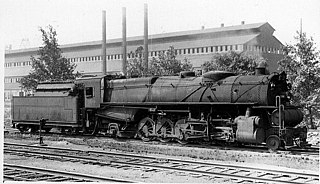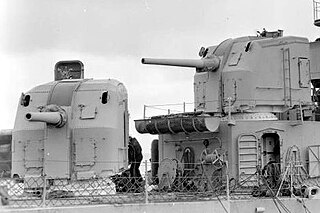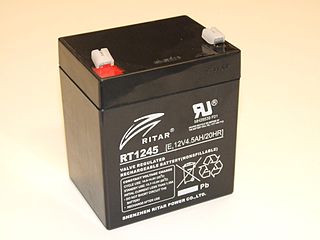In-Cell Charge Control or I-C3 is a method for very rapid charging of a Nickel-metal hydride battery, patented by Rayovac. Batteries using this technology are commonly sold as "15-minute rechargeables".
The charge control consists of a pressure switch built into the cell, which disconnects the charging current when the internal cell pressure rises above a certain limit; usually 200 pounds per square inch (1.4 MPa ) to 300 pounds per square inch (2.1 MPa). This prevents overcharging and damage to the cell.

A nickel–metal hydride battery is a type of rechargeable battery. The chemical reaction at the positive electrode is similar to that of the nickel-cadmium cell (NiCd), with both using nickel oxide hydroxide (NiOOH). However, the negative electrodes use a hydrogen-absorbing alloy instead of cadmium. NiMH batteries can have two to three times the capacity of NiCd batteries of the same size, with significantly higher energy density, although only about half that of lithium-ion batteries.

The nickel–cadmium battery is a type of rechargeable battery using nickel oxide hydroxide and metallic cadmium as electrodes. The abbreviation Ni–Cd is derived from the chemical symbols of nickel (Ni) and cadmium (Cd): the abbreviation NiCad is a registered trademark of SAFT Corporation, although this brand name is commonly used to describe all Ni–Cd batteries.

An air compressor is a machine that takes ambient air from the surroundings and discharges it at a higher pressure. It is an application of a gas compressor and a pneumatic device that converts mechanical power into potential energy stored in compressed air, which has many uses. A common application is to compress air into a storage tank, for immediate or later use. When the delivery pressure reaches its set upper limit, the compressor is shut off, or the excess air is released through an overpressure valve. The compressed air is stored in the tank until it is needed. The pressure energy provided by the compressed air can be used for a variety of applications such as pneumatic tools as it is released. When tank pressure reaches its lower limit, the air compressor turns on again and re-pressurizes the tank. A compressor is different from a pump because it works on a gas, while pumps work on a liquid.

The Apollo command and service module (CSM) was one of two principal components of the United States Apollo spacecraft, used for the Apollo program, which landed astronauts on the Moon between 1969 and 1972. The CSM functioned as a mother ship, which carried a crew of three astronauts and the second Apollo spacecraft, the Apollo Lunar Module, to lunar orbit, and brought the astronauts back to Earth. It consisted of two parts: the conical command module, a cabin that housed the crew and carried equipment needed for atmospheric reentry and splashdown; and the cylindrical service module which provided propulsion, electrical power and storage for various consumables required during a mission. An umbilical connection transferred power and consumables between the two modules. Just before reentry of the command module on the return home, the umbilical connection was severed and the service module was cast off and allowed to burn up in the atmosphere.

The Stanley Motor Carriage Company was an American manufacturer of steam cars that operated from 1902 to 1924, going defunct after it failed to adapt to competition from rapidly improving Internal combustion engine vehicles. The cars made by the company were colloquially called Stanley Steamers although several different models were produced.

The Pennsylvania Railroad's N1s was a class of steam locomotive built for Lines West. They were of 2-10-2 "Santa Fe" wheel arrangement, ten driving wheels with a two-wheel leading truck and a two-wheel cast KW-pattern trailing truck under a giant firebox. This arrangement was well suited to the N1s' intended purpose, which was as a heavy drag freight engine for coal and iron ore traffic to and from lakeside ports. The design was developed by the PRR's Fort Wayne Shops and orders were placed with Alco (Brooks) and Baldwin for a total of 60; the first Alco locomotive was delivered in December 1918, with the remainder arriving during 1919.

The DynaTAC is a series of cellular telephones manufactured by Motorola from 1983 to 1994. The Motorola DynaTAC 8000X received approval from the U.S. FCC on September 21, 1983. A full charge took roughly 10 hours, and it offered 30 minutes of talk time. It also offered an LED display for dialing or recall of one of 30 phone numbers. It was priced at $3,995 in 1984, its commercial release year, equivalent to $11,253 in 2022. DynaTAC was an abbreviation of "Dynamic Adaptive Total Area Coverage".

Maytag blue cheese is produced on the Maytag Dairy Farms just outside of Newton, Iowa city limits.

A steam whistle is a device used to produce sound in the form of a whistle using live steam, which creates, projects, and amplifies its sound by acting as a vibrating system.
Copper units of pressure or CUP, and the related lead units of pressure or LUP, are terms applied to pressure measurements used in the field of internal ballistics for the estimation of chamber pressures in firearms. These terms were adopted by convention to indicate that the pressure values were measured by copper crusher and lead crusher gauges respectively. In recent years, they have been replaced by the adoption of more modern piezoelectric pressure gauges that more accurately measure chamber pressures and generally give significantly higher pressure values. This nomenclature was adopted to avoid confusion and the potentially dangerous interchange of pressure values and standards made by different types of pressure gauges. For example, it makes little sense to describe a maximum pressure as 300 MPa, and in case the pressure has been measured according to the CUP procedure it should be denoted as 300 MPa (CUP).

A rechargeable alkaline battery, also known as alkaline rechargeable or rechargeable alkaline manganese (RAM), is a type of alkaline battery that is capable of recharging for repeated use. The formats include AAA, AA, C, D, and snap-on 9-volt batteries. Rechargeable alkaline batteries are manufactured fully charged and have the ability to hold their charge for years, longer than nickel-cadmium and nickel-metal hydride batteries, which self-discharge. Rechargeable alkaline batteries can have a high recharging efficiency and have less environmental impact than disposable cells.

The Mark 12 5"/38 caliber gun was a United States dual-purpose naval gun, but also installed in single-purpose mounts on a handful of ships. The 38 caliber barrel was a mid-length compromise between the previous United States standard 5"/51 low-angle gun and 5"/25 anti-aircraft gun. United States naval gun terminology indicates the gun fired a projectile 5 inches (127 mm) in diameter, and the barrel was 38 calibers long. The increased barrel length provided greatly improved performance in both anti-aircraft and anti-surface roles compared to the 5"/25 gun. However, except for the barrel length and the use of semi-fixed ammunition, the 5"/38 gun was derived from the 5"/25 gun. Both weapons had power ramming, which enabled rapid fire at high angles against aircraft. The 5"/38 entered service on USS Farragut, commissioned in 1934, the first new destroyer design since the last Clemson was built in 1922. The base ring mount, which improved the effective rate of fire, entered service on USS Porter, commissioned in 1936.

A valve regulated lead–acid (VRLA) battery, commonly known as a sealed lead–acid (SLA) battery, is a type of lead–acid battery characterized by a limited amount of electrolyte absorbed in a plate separator or formed into a gel; proportioning of the negative and positive plates so that oxygen recombination is facilitated within the cell; and the presence of a relief valve that retains the battery contents independent of the position of the cells.
Eglin steel (ES-1) is a high-strength, high-performance, low-alloy, low-cost steel, developed for a new generation of bunker buster type bombs, e.g. the Massive Ordnance Penetrator and the improved version of the GBU-28 bomb known as EGBU-28. It was developed in collaboration between the US Air Force and the Ellwood National Forge Company.

A primarylife support system (PLSS), is a device connected to an astronaut or cosmonaut's spacesuit, which allows extra-vehicular activity with maximum freedom, independent of a spacecraft's life support system. A PLSS is generally worn like a backpack. The functions performed by the PLSS include:

A pressure regulator is a valve that controls the pressure of a fluid to a desired value, using negative feedback from the controlled pressure. Regulators are used for gases and liquids, and can be an integral device with a pressure setting, a restrictor and a sensor all in the one body, or consist of a separate pressure sensor, controller and flow valve.

A nickel–hydrogen battery (NiH2 or Ni–H2) is a rechargeable electrochemical power source based on nickel and hydrogen. It differs from a nickel–metal hydride (NiMH) battery by the use of hydrogen in gaseous form, stored in a pressurized cell at up to 1200 psi (82.7 bar) pressure. The nickel–hydrogen battery was patented on February 25, 1971 by Alexandr Ilich Kloss and Boris Ioselevich Tsenter in the United States.
The Taff Vale Railway U and U1 classes were 0-6-2T steam tank locomotive operated by Taff Vale Railway, Wales, from 1895. All were still in use when the Taff Vale Railway was acquired by the Great Western Railway in 1922 but were withdrawn from traffic between 1927 and 1931.

The pound per square inch or, more accurately, pound-force per square inch, is a unit of measurement of pressure or of stress based on avoirdupois units. It is the pressure resulting from a force with magnitude of one pound-force applied to an area of one square inch. In SI units, 1 psi is approximately 6,895 pascals.

The 3-inch ordnance rifle, model 1861 was a wrought iron muzzleloading rifled cannon that was adopted by the United States Army in 1861 and widely used in field artillery units during the American Civil War. It fired a 9.5 lb (4.3 kg) projectile to a distance of 1,830 yd (1,670 m) at an elevation of 5°. The 3-inch rifle was not as effective in firing canister shot as the heavier 12-pounder Napoleon, but it proved to be highly accurate at longer ranges when firing common shell or spherical case shot. There was only one reported case of a 3-inch ordnance rifle bursting in action. This was in stark contrast to the similarly-sized cast iron 10-pounder Parrott rifles which occasionally burst without warning, inflicting injury on the gun crews. The Confederate States of America lacked the technology to manufacture reliable copies of the 3-inch ordnance rifle. However, the Confederate States Army respected the weapons and employed those captured from Federal forces.